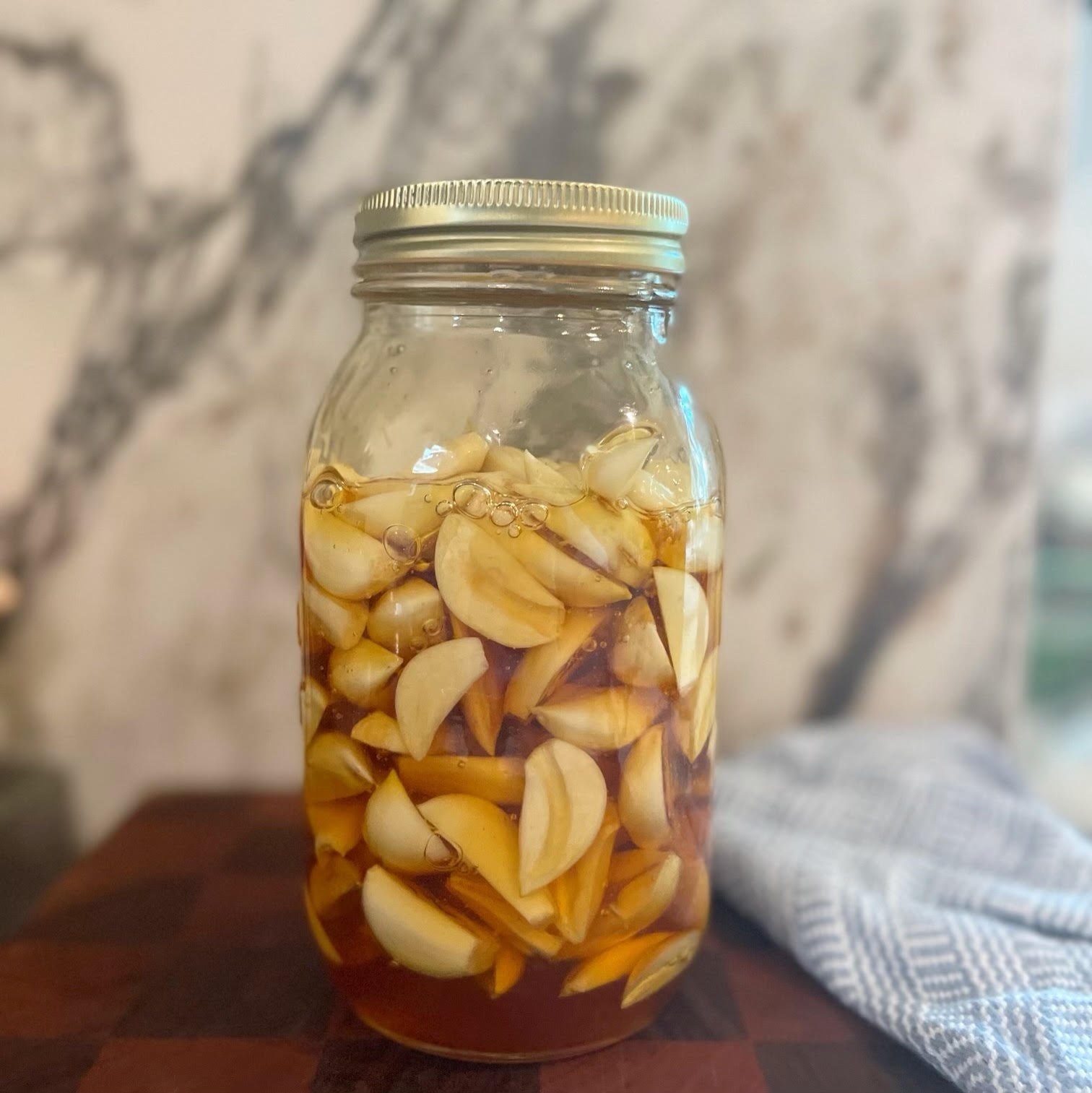Fermented Garlic Honey
With colder weather on its way, it’s time to start adding some beneficial remedies to your toolbox for cold & flu season! Garlic and honey have both been used together and separately across a variety of cultures for thousands of years. I pulled this quote from an interesting review Historical Perspective on the Use of Garlic, from the Journal of Nutrition. It might have been written in 2001, but it’s relevance still stands!
Garlic was in use at the beginning of recorded history and was found in Egyptian pyramids and ancient Greek temples. There are Biblical references to garlic. Ancient medical texts from Egypt, Greece, Rome, China and India each prescribed medical applications for garlic. In many cultures, garlic was administered to provide strength and increase work capacity for laborers. Hippocrates, the revered physician, prescribed garlic for a variety of conditions. Garlic was given to the original Olympic athletes in Greece, as perhaps one of the earliest “performance enhancing” agents. (1).
When is comes to honey, the story is very similar. The use of honey, by humans, can be traced to around 8000 years ago with the help of paintings dated from the Stone Age. It has subsequently been used for its medicinal properties by the ancient Egyptians, ancient Greeks, as well as in traditional Chinese and Indian Ayurvedic medicine (2).
Garlic and honey have both been shown in various studies to posses antiviral and antibacterial properties. When you combine them and allow them to ferment you are also allowing the growth of healthy bacteria. Taste-wise, it definitely doesn’t hurt to cut the sharp and strong taste of garlic with sweet and powerful honey.
To eat it when it’s done fermenting, just take a spoonful of honey, a whole garlic clove, or maybe a little bit of both when you start to feel a bit run down. This would also be great to add into your meals, on things like toast, tea, salads, etc… . The options are vast!
This simple recipe was super easy to make, even though peeling the garlic was time consuming. It’s great for your immune system due to the medicinal properties of garlic & raw honey and can be enjoyed in a variety of ways. It’s beneficial for the kiddos too! To reduce the (small) risk of botulism occurring, you can add a teaspoon of apple cider vinegar every few months.
Ingredients
* indicates item purchased at the farmers market
*3-4 cups of Bee2Bee honey. This can vary depending on the quantity you decide to make. The goal is to have the honey completely cover the amount of garlic you use.
5-6 pods of garlic, peeled and sliced or smashed
Method
Separate each individual garlic clove from their pods and remove the skin from all of the cloves.
Smash or slice each garlic clove before you place them in a jar to help the honey permeate into the cloves. Fun Fact: Smashing garlic also releases an enzyme that helps catalyze the production of organosulfur compounds, which give the garlic it’s medicinal qualities!
Add the garlic cloves to a jar and then add enough honey to completely cover the cloves. Close the jar and gently flip upside down a few times to make sure the cloves are completely coated.
Loosen the lid a bit so air can escape while the fermentation process takes place. Leave in a dark cool place for at least a month. Tighten the lid and flip the jar to mix the honey and garlic every few days to ensure the cloves remain coated with honey. Don’t forget to re-loosen the lid when you’re done mixing.
Alternatively you can always keep the lid tightly closed and open the jar once a day to let gas escape. You can also take this time to mix the honey and garlic cloves by flipping the jar.
Pay attention to the jar! If you see bubbles forming, you know the fermentation process is working! You’ll know that it is ready to consume when the honey becomes slightly runnier and the garlic does not float as much as it used to.
Thank you for following along and supporting local!
xxCB
Literature Cited
Richard S. Rivlin, Historical Perspective on the Use of Garlic, The Journal of Nutrition, Volume 131, Issue 3, 2001, Pages 951S-954S, ISSN 0022-3166, https://doi.org/10.1093/jn/131.3.951S (https://www.sciencedirect.com/science/article/pii/S0022316622147760)
Eteraf-Oskouei T, Najafi M. Traditional and modern uses of natural honey in human diseases: a review. Iran J Basic Med Sci. 2013 Jun;16(6):731-42. PMID: 23997898; PMCID: PMC3758027.

